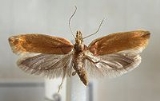
Ypsolopha ustella
Encyclopedia
The Variable Ypsolopha Moth (Ypsolopha ustella) is a moth
of the family Ypsolophidae
. It is found in most of Europe
and is also present in North America
.
The wingspan
is 15–20 mm. It is a variable species with numerous colour forms. Adults are on wing from mid July to April in western Europe, but can be on wing nearly year round depending on the location. The species overwinters as an adult.
The larvae feed on the upperside of the leaves of Quercus species. They live under a slight web. Pupation takes place in a whitish boat-shaped cocoon on a leaf, trunk, or amongst leaf-litter on the ground.
Moth
A moth is an insect closely related to the butterfly, both being of the order Lepidoptera. Moths form the majority of this order; there are thought to be 150,000 to 250,000 different species of moth , with thousands of species yet to be described...
of the family Ypsolophidae
Ypsolophidae
Ypsolophidae is a family of moth. They are included in the Plutellidae by many authors.-Ypsolophinae:* Phrealcia Chrétien, 1900** Phrealcia brevipalpella Chrétien, 1900** Phrealcia eximiella...
. It is found in most of Europe
Europe
Europe is, by convention, one of the world's seven continents. Comprising the westernmost peninsula of Eurasia, Europe is generally 'divided' from Asia to its east by the watershed divides of the Ural and Caucasus Mountains, the Ural River, the Caspian and Black Seas, and the waterways connecting...
and is also present in North America
North America
North America is a continent wholly within the Northern Hemisphere and almost wholly within the Western Hemisphere. It is also considered a northern subcontinent of the Americas...
.
The wingspan
Wingspan
The wingspan of an airplane or a bird, is the distance from one wingtip to the other wingtip. For example, the Boeing 777 has a wingspan of about ; and a Wandering Albatross caught in 1965 had a wingspan of , the official record for a living bird.The term wingspan, more technically extent, is...
is 15–20 mm. It is a variable species with numerous colour forms. Adults are on wing from mid July to April in western Europe, but can be on wing nearly year round depending on the location. The species overwinters as an adult.
The larvae feed on the upperside of the leaves of Quercus species. They live under a slight web. Pupation takes place in a whitish boat-shaped cocoon on a leaf, trunk, or amongst leaf-litter on the ground.

